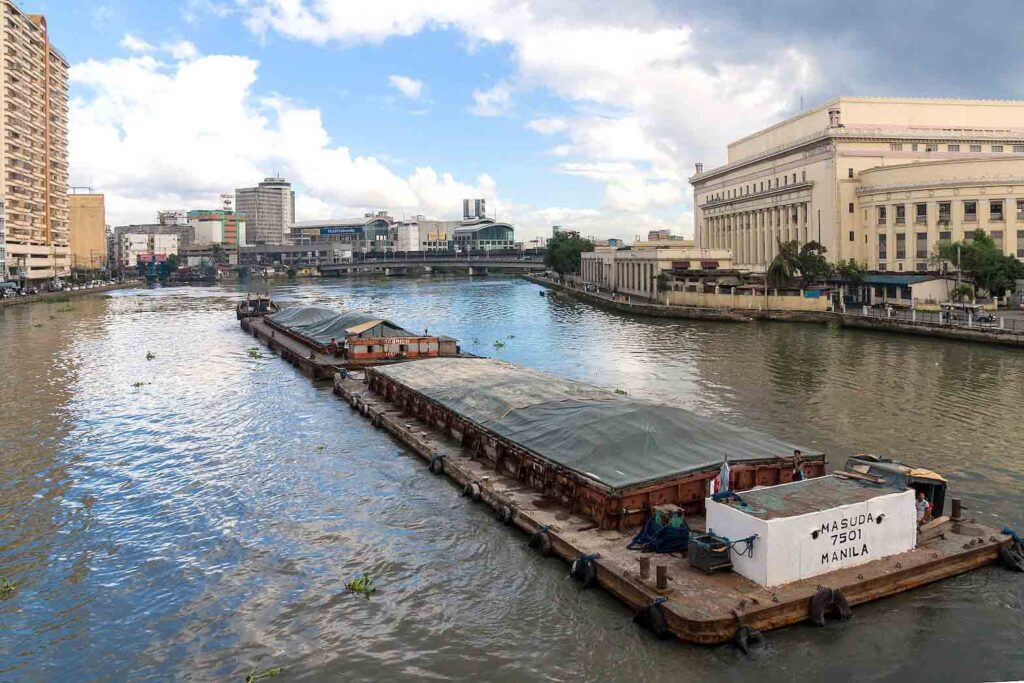
Manila, Philippines: The Post Office Building and the Pasig River, seen from the Jones Bridge. Photo by CEphoto, Uwe Aranas
MANILA—This is a metropolis highly infatuated with expressways, of which there are ten, including the South Luzon Expressway (SLEX), North Luzon Expressway (NLEX), Skyway 1 to 3, and Cavite Expressway (CAVITEX). The argument for constructing these is that they decongest traffic and thus increase the flow of vehicles from point A to point B. But it’s an argument based as well on a love for vehicles of all types and sizes: from the ubiquitous jeepneys, passenger buses, humongous trucks to cars, sedans, and sports utility vehicles (SUVs). Add to the mix motorcycles, tricycles, scooters, and bicycles, and you have every imaginable vehicle navigating the metropolitan region’s roads.
On this visit, the first since the lockdown, I noticed a sizeable increase of motorcycles for hire, complete with drivers. Via apps, these can be hired to ferry one to one’s workplace or to home. Two main ones are Joyride and Angkas, the latter a term that means “to hitch a ride.” Needless to say these two-wheeled taxis can easily weave in and out of traffic, leaving the rest of us stuck in our vehicles.
As anyone who has ever lived in this region by Manila Bay or visited, even if briefly, for decades now snail-paced traffic has been a major headache for its denizens. What causes such traffic jams but an overabundance of vehicles. One would think therefore that to decongest the city’s streets and byways one obvious solution is to decrease the number of vehicles on the road. And yet, when an expressway is added to a city’s transportation infrastructure, traffic simply gets rerouted without lessening the overwhelming and oppressive presence of vehicles. On the contrary, expressways benefit the automotive industry. If you build them, they will come.
The Skyway that connects the SLEX and the NLEX, the expressways that lead respectively to the south and the north does lessen the travel time between the two termini. But one wonders why a railway wasn’t built as well between the two end points of the elevated expressway, as that would benefit the commuter with low-cost fares, as well as the environment that as we now know is constantly assaulted by fossil fuels, exacerbating global warming. Even as other countries are adopting policies to lessen their dependence on fossil fuels, we seem to be charging in the opposite direction.
Now comes a proposal to build the Pasig River Expressway (PAREX), a six-lane 19-kilometer elevated highway parallel to and often right above the Pasig River, an important riverine artery that links up the country’s largest lake, Laguna de Bay, with Manila Bay. Many of the expressway’s structural columns will need to be embedded deep in the river bed, inevitably harming it. Again, the same rationale is advanced: it will speed up commuting, lessen traffic congestion, etc. Its proponents seem intent on uglifying a natural resource, instead of developing it into an ecologically sound, beautiful and natural riverine complex that protects the Pasig while encouraging leisurely human activity rather than internal combustion engines. With very little green space in the metropolitan region—malls, malls, malls everywhere—the river banks could be the site of tree-lined promenades, bike lanes, mini-parks, and cafes. And the current ferry service could certainly be improved and expanded.
You may like:
Some say that PAREX may well be the magic bullet that will remedy the metropolis’s traffic woes. Wishful thinking. Let’s be clear about it: the city loses every time cars take priority over mass transportation. And that is to further disadvantage the already overburdened working man and woman.
Hard to imagine now but those old enough to remember Manila in the 1950s and early 1960s say that the river was clean enough to swim in. And on its banks by the delta emerged pre-Hispanic kingdoms, including Tondo and Maynilad. Paintings, such as those by Amorsolo, depicted the river in idyllic, pastoral scenes. Hard to imagine that, as well.
The Pasig, like all rivers, needs to be protected. Biologically dead for some decades, steps to clean it up have helped to revive it, so a full recovery is certainly attainable but only if this harebrained proposal, and any other such proposal, is unceremoniously shot down. Or drowned.
Copyright L.H. Francia 2023

